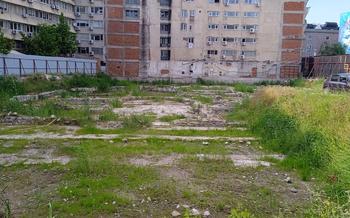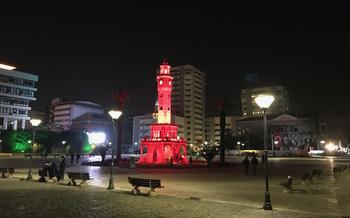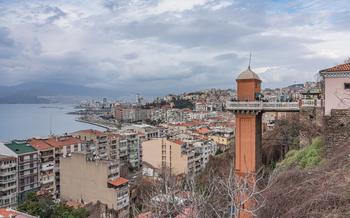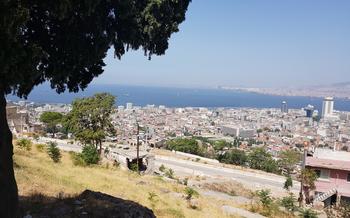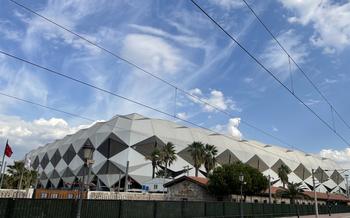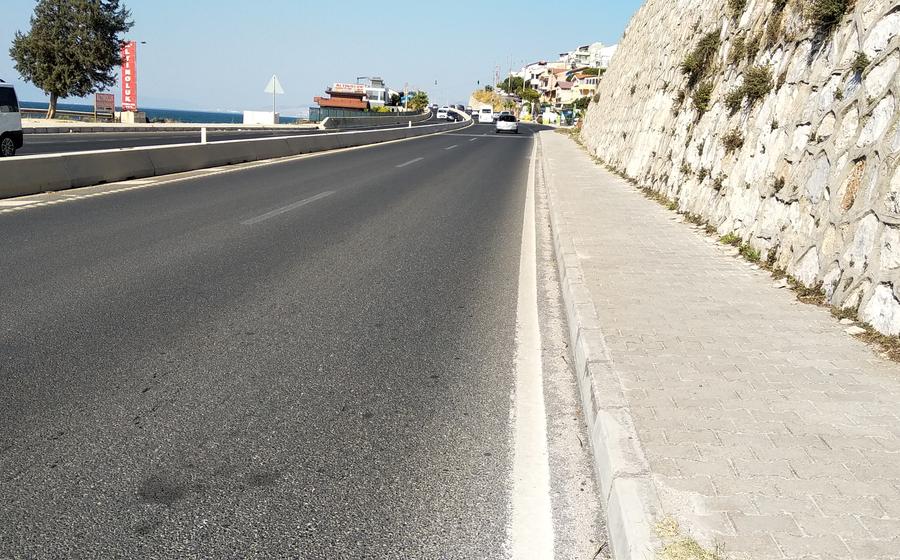
Hippodrome of Smyrna
- The Ruins of Antiquity
- Equestrian Contests and Performances
- Political and Cultural Events
- The Hippodrome's Legacy
- Tips for Visiting the Hippodrome
- The Ancient City of Smyrna
- Exploring the Agora
- The Archaeological Museum of Izmir
- The Kemeraltı Bazaar
- The Clock Tower of Izmir
- The Alsancak District
- The Karşıyaka District
- The Bostanli District
- Insider Tip
The Ruins of Antiquity
The Hippodrome of Smyrna, also known as the Hippodrome of Symrna, is a remarkable ancient stadium located in the heart of modern-day Izmir, Turkey. Constructed in the 2nd century AD during the Roman Empire, it served as a prominent venue for chariot races, athletic competitions, and other spectacles that enthralled the citizens of ancient Smyrna. This magnificent structure stands as a testament to the city's rich history and enduring legacy.
The hippodrome was a significant part of ancient Greek and Roman culture, serving as a hub for entertainment, sports, and social gatherings. In Smyrna, the hippodrome played a crucial role in shaping the city's identity and providing a sense of community among its inhabitants. Over the centuries, it underwent several modifications and expansions, reflecting the changing needs and tastes of the population.
Today, the ruins of the Hippodrome of Smyrna offer a glimpse into the grandeur of this ancient sporting arena. Visitors can explore the remnants of the stadium, including the starting gates, the spina (central divider), and the seating tiers that once accommodated thousands of spectators. The architectural features of the hippodrome, such as the arched entrances, intricate carvings, and decorative columns, provide valuable insights into the artistry and engineering prowess of the ancient world.
Equestrian Contests and Performances
The Hippodrome of Smyrna was a central venue for equestrian contests and performances, drawing spectators from far and wide. Chariot races were the most popular event, with teams competing for glory and prizes. The excitement and rivalry were palpable as the chariots thundered around the track, cheered on by the enthusiastic crowd.
The skills of the charioteers and horses were put to the test as they navigated the perilous turns and straightaways of the hippodrome. Crashes and accidents were common, adding an element of danger to the races. The victorious charioteer would be hailed as a hero and showered with accolades.
In addition to chariot races, the hippodrome also hosted other equestrian events, such as horse races and trick riding demonstrations. Acrobats, musicians, and other performers entertained the crowd during intervals between races, creating a lively and festive atmosphere.
Political and Cultural Events
The hippodrome of Smyrna was not just a venue for horse races and athletic competitions, but also a stage for political gatherings, proclamations, and religious ceremonies. It served as a platform for the city's leaders to address the public, announce important decisions, and rally support for their policies. The hippodrome played a significant role in shaping public opinion and promoting civic identity, as it brought together citizens from all walks of life to witness and participate in these events.
Furthermore, the hippodrome hosted a variety of festivals, parades, and other cultural events that celebrated the city's heritage and traditions. These events showcased the artistic and cultural achievements of Smyrna, and provided a space for people to come together and share their pride in their city. The hippodrome was a hub of cultural exchange, as it welcomed performers, artists, and visitors from across the region, contributing to the vibrant cultural tapestry of ancient Smyrna.
The Hippodrome's Legacy
The Hippodrome of Smyrna has left a lasting legacy on the development of urban planning and architecture. Its unique design and purpose have influenced the construction of later sporting venues and entertainment complexes worldwide. The hippodrome's grandstands, with their tiers of seating and elaborate decorations, served as a model for later amphitheaters and stadiums. The central arena, with its long, narrow track, became the standard for chariot racing courses.
The hippodrome's role as a center of public entertainment and civic identity has also had a profound impact on modern urban planning. The concept of a large, open space dedicated to public events and spectacles has been adopted by cities worldwide, from the plazas of Europe to the central parks of North America. The hippodrome's legacy can also be seen in the design of modern sporting venues, which often incorporate elements of classical architecture and design.
Beyond its physical legacy, the Hippodrome of Smyrna has also had a lasting impact on our cultural heritage. The stories of the chariot races, the excitement of the crowds, and the pageantry of the events have been immortalized in literature, art, and film. The hippodrome has become a symbol of the ancient world, a reminder of the grandeur and spectacle of a bygone era.
Preserving and restoring the Hippodrome of Smyrna is crucial to ensuring that its legacy continues to inspire and educate future generations. By protecting this ancient site, we are not only preserving a valuable piece of history but also celebrating the enduring power of human creativity and innovation.
Tips for Visiting the Hippodrome
Getting There:
The Hippodrome of Smyrna is located in the heart of the city of Izmir, making it easily accessible by public transportation. The nearest tram stop is "Konak," which is just a short walk from the site. Alternatively, you can take a taxi or ride-sharing service to the hippodrome.
Best Time to Visit:
The best time to visit the Hippodrome of Smyrna is early in the morning or late in the afternoon, when the temperatures are cooler and the crowds are smaller. This will allow you to fully appreciate the site's atmosphere and take your time exploring the ruins without feeling rushed.
What to Look for:
As you explore the Hippodrome of Smyrna, be sure to pay attention to the architectural details and historical markers. Look for the remains of the starting gate, the spina, and the seating tiers. You can also see the foundations of the temple dedicated to the goddess Nemesis, which was once located at the end of the track.
Capturing Memorable Photos:
To capture memorable photos of the Hippodrome of Smyrna, try to find different angles and perspectives. Experiment with different lighting conditions, such as the golden light of sunrise or sunset. You can also use a wide-angle lens to capture the entire site in one shot.
The Ancient City of Smyrna
Smyrna, the ancient city that once stood on the shores of the Aegean Sea, was a bustling port city and cultural center. Founded in the 11th century BC by Aeolian Greeks, Smyrna quickly grew in importance due to its strategic location and natural harbor. The city became a major trading hub, connecting the East with the West, and a center of Hellenistic culture, attracting philosophers, artists, and scholars from across the ancient world.
Over the centuries, Smyrna was ruled by various empires, including the Persians, Romans, and Byzantines, each leaving their mark on the city's history and architecture. The city's prosperity continued throughout the Middle Ages, as it became a center of Byzantine Christianity and a major trading center for the Byzantine Empire. However, Smyrna's fortunes declined after the Ottoman conquest in the 15th century, and the city was largely destroyed by a series of fires and earthquakes.
Despite these setbacks, Smyrna remained an important city throughout the Ottoman period, and in the 19th century, it experienced a revival as a major trading center and a center of Greek culture. The city's cosmopolitan atmosphere and vibrant cultural life attracted people from all over the world, and Smyrna became known as the "Pearl of the Aegean."
Today, Izmir, the modern city that stands on the site of ancient Smyrna, is a vibrant and cosmopolitan city, with a rich history and a diverse culture. The city is home to many ancient ruins and historical sites, including the Hippodrome of Smyrna, the Agora, and the Archaeological Museum of Izmir, which offer a glimpse into the city's rich past.
Exploring the Agora
The agora, situated in the heart of ancient Smyrna, was a bustling marketplace and a focal point of civic life. This vibrant public space served as a hub for commerce, politics, and social interaction, attracting merchants, traders, and citizens from all walks of life.
The agora was meticulously organized into distinct sections, each dedicated to specific activities. The stoas, or covered colonnades, lined the perimeter, providing shelter from the sun and rain. Within these stoas, merchants displayed their wares, from exotic spices and textiles to locally produced pottery and metalwork. The agora also featured temples dedicated to various deities, where citizens could offer prayers and seek divine guidance.
In addition to commercial and religious functions, the agora served as a venue for political gatherings and public assemblies. Here, citizens could voice their opinions, debate important issues, and participate in the decision-making process. The agora was a platform for shaping public opinion and promoting civic identity, fostering a sense of community among the inhabitants of ancient Smyrna.
The agora's proximity to the hippodrome is particularly noteworthy, as both structures played crucial roles in the urban fabric of ancient Smyrna. The hippodrome provided entertainment and spectacle, while the agora facilitated commerce and civic engagement. Together, these two landmarks formed the core of the city's public life, contributing to its vibrant atmosphere and cultural significance.
The Archaeological Museum of Izmir
Situated in the heart of Izmir, Turkey, the Archaeological Museum of Izmir is a treasure trove of ancient artifacts and relics that offer a glimpse into the rich history and culture of the region. Among its extensive collection are exhibits related to the Hippodrome of Smyrna and other significant archaeological sites in the vicinity.
The museum's collection of artifacts from the hippodrome includes intricate sculptures, inscriptions, and architectural fragments that shed light on the grandeur and significance of this ancient sporting venue. Visitors can admire statues of victorious charioteers, marvel at the finely carved reliefs depicting scenes from the races, and examine the remains of the hippodrome's elaborate seating arrangements.
Beyond the hippodrome, the museum also houses a diverse collection of artifacts from prehistoric, classical, and Byzantine periods. From delicate pottery and jewelry to monumental sculptures and mosaics, the museum's exhibits provide a comprehensive overview of the region's artistic and cultural heritage.
By exploring the Archaeological Museum of Izmir, visitors can gain a deeper understanding of the Hippodrome of Smyrna and its place within the broader context of ancient Greek and Roman civilization. The museum's collection offers a tangible connection to the past, allowing visitors to appreciate the artistry, craftsmanship, and cultural significance of this remarkable ancient site.
The Kemeraltı Bazaar
In the heart of İzmir, a vibrant tapestry of commerce and history unfolds at the Kemeraltı Bazaar. Situated a short stroll from the ancient Hippodrome of Smyrna, this bustling marketplace has been a focal point of trade and social interaction for centuries. Its narrow cobblestone streets wind their way through a labyrinth of shops, stalls, and caravanserais, each offering a unique treasure trove of goods.
From the aromatic spices that fill the air to the colorful textiles that adorn the storefronts, the Kemeraltı Bazaar is a feast for the senses. Here, you can find everything from traditional Turkish handicrafts to modern souvenirs, as well as an array of fresh produce, dried fruits, and delectable sweets. The bazaar's lively atmosphere is further enhanced by the friendly banter of vendors and the cheerful hum of bargaining customers.
As you explore the Kemeraltı Bazaar, you'll discover hidden courtyards and historical landmarks that speak to the rich heritage of İzmir. The Hisar Mosque, with its elegant minaret, stands as a testament to the city's Ottoman past, while the Armenian Church of Surp Asdvadzadzin, with its intricate frescoes, offers a glimpse into the vibrant Armenian community that once thrived here.
Whether you're seeking unique souvenirs, authentic Turkish delights, or simply a glimpse into the soul of İzmir, the Kemeraltı Bazaar is an essential stop on any visit to the city. Lose yourself in its vibrant maze of shops, savor the flavors of traditional Turkish cuisine, and embrace the infectious energy of this bustling marketplace.
The Clock Tower of Izmir
Standing tall in the heart of Konak Square, the Clock Tower of Izmir proudly serves as a symbol of the city. Its construction, completed in 1901, was commissioned by Sultan Abdulhamid II to commemorate the 25th anniversary of his reign. Designed by the French architect Raymond Charles Père, the tower draws inspiration from both Ottoman and European architectural styles.
Adorned with intricate carvings and decorative elements, the Clock Tower showcases a blend of Islamic and Western motifs. Its four faces feature large clocks, meticulously crafted to display the time accurately. The tower's height, reaching approximately 25 meters, allows it to be visible from various points in the city, serving as a prominent landmark.
Over the years, the Clock Tower has witnessed countless historical events and developments in Izmir. It has become an integral part of the city's identity, deeply cherished by locals and admired by visitors. Today, the tower stands as a symbol of Izmir's rich history and cultural heritage, attracting tourists from around the world who come to marvel at its beauty and capture its essence in photographs.
The Alsancak District
The Alsancak district is a vibrant and modern area of İzmir, located just a short walk from the Hippodrome of Smyrna. It has a rich history dating back to the 19th century when it was a popular destination for European merchants and traders. Today, Alsancak is a bustling hub of activity, with a diverse mix of shops, restaurants, bars, and cultural attractions.
Alsancak is home to a number of theaters, cinemas, and art galleries, making it a popular destination for culture vultures. The district is also home to the İzmir State Opera and Ballet, which stages regular performances throughout the year. For those who enjoy shopping, Alsancak offers a wide range of options, from traditional Turkish bazaars to modern shopping malls.
The Alsancak district is a great place to experience the modern side of İzmir. It is a vibrant and cosmopolitan area with a lot to offer visitors. Whether you are looking for shopping, dining, or entertainment, you are sure to find something to your taste in Alsancak.
The Karşıyaka District
Across the Gulf of Izmir lies the vibrant district of Karşıyaka, a popular residential and commercial area that offers a unique blend of history, culture, and natural beauty. Known for its stunning views of the city skyline and the sparkling waters of the gulf, Karşıyaka invites visitors to explore its charming streets, bustling markets, and beautiful beaches.
One of the highlights of Karşıyaka is its picturesque waterfront promenade, which stretches for several kilometers along the coast. Here, visitors can stroll, jog, or cycle while enjoying panoramic views of the city and the surrounding mountains. The promenade is also home to numerous cafes, restaurants, and shops, making it a popular spot for locals and tourists alike.
For those seeking relaxation and recreation, Karşıyaka offers a variety of beautiful beaches. The most popular beach in the district is Karşıyaka Plajı, which boasts crystal-clear waters, soft golden sand, and a range of amenities such as sunbeds, umbrellas, and water sports facilities. Other popular beaches in the area include Mavişehir Plajı and Bostanlı Plajı, which offer a more secluded and tranquil atmosphere.
Karşıyaka is also home to several parks and green spaces, providing a welcome respite from the hustle and bustle of city life. The largest park in the district is Karşıyaka Parkı, which features lush gardens, walking trails, and a children's playground. Another popular park is Bostanlı Parkı, which is located along the coast and offers stunning views of the Gulf of Izmir.
With its beautiful beaches, parks, and vibrant atmosphere, Karşıyaka is a must-visit destination for anyone exploring the city of İzmir. Whether you're looking to relax on the beach, explore the local markets, or simply enjoy the stunning scenery, Karşıyaka has something to offer everyone.
The Bostanli District
The Bostanli district is a modern and upscale area located on the western coast of the Gulf of Izmir. It is known for its luxurious hotels, restaurants, and shops, catering to tourists and locals alike. The district has undergone significant development in recent years, transforming it into a vibrant and cosmopolitan hub.
One of the main attractions of Bostanli is its beautiful coastline, which offers stunning views of the Aegean Sea. The district is home to several popular beaches, including Bostanli Beach, which is known for its crystal-clear waters and golden sands. Visitors can enjoy swimming, sunbathing, and various water sports activities at these beaches.
In addition to its beaches, Bostanli is also home to several parks and green spaces, providing residents and visitors with opportunities for relaxation and recreation. The Bostanli Park is a popular spot for picnics, jogging, and cycling. It also features a playground and a small zoo, making it a great place for families to visit.
The Bostanli district is well-connected to the rest of Izmir by public transportation, making it easy for visitors to reach the city center and other attractions. It is also home to several shopping malls, cinemas, and cultural centers, offering a variety of entertainment options for residents and visitors alike.
Overall, the Bostanli district is a vibrant and modern area that offers a mix of luxury, natural beauty, and cultural attractions. It is a great place to stay for those looking for a more upscale and cosmopolitan experience in Izmir.
Insider Tip
A Hidden Gem:
Venture beyond the main ruins of the Hippodrome of Smyrna to discover a hidden gem: the ancient cistern located beneath the site. This subterranean reservoir, dating back to the Roman period, is a remarkable feat of engineering and offers a unique glimpse into the city's water management system. Descend into the cistern's cool depths and marvel at its vaulted ceilings, intricate channels, and the echoing acoustics that create a mystical ambiance. It's a hidden treasure that transports you back in time and provides a deeper appreciation for the ingenuity of ancient civilizations.
Personal Anecdote:
During my exploration of the Hippodrome of Smyrna, I stumbled upon a group of local children playing among the ruins. Their laughter and joy echoed through the ancient stone structures, creating a heartwarming contrast to the site's historical significance. It reminded me that history is not just about the past but also about the present and the future. These children were the inheritors of this ancient legacy, and their presence brought a sense of continuity and vitality to the site.
Practical Advice:
To fully appreciate the Hippodrome of Smyrna, visit during the early morning or late afternoon when the crowds are fewer, and the light is at its most beautiful. This will allow you to soak in the atmosphere and capture stunning photographs without distractions. Additionally, consider hiring a local guide who can provide insights into the history and significance of the site, bringing the ruins to life with their knowledge and passion.
Culinary Delights:
After exploring the hippodrome, head to one of the nearby restaurants in the Agora district to savor the flavors of traditional Turkish cuisine. Indulge in delectable dishes like "Kumru," a toasted sandwich filled with cheese, tomato, and sausage, or sample the fresh seafood caught daily from the Aegean Sea. These culinary delights will tantalize your taste buds and provide a delightful end to your journey through history.
